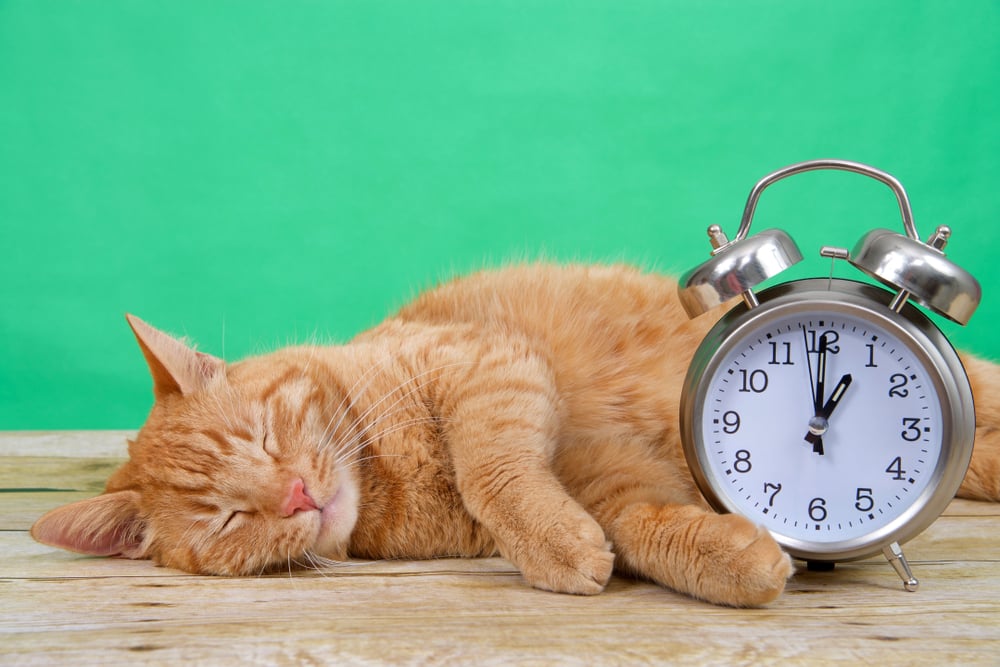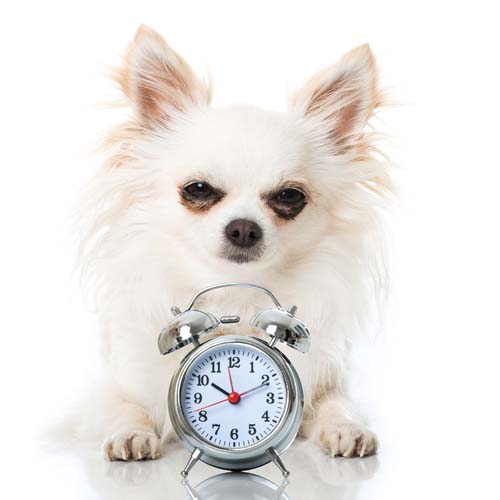
Table of Contents
Pets might not understand the concept of minutes and hours the way we do, but they have a sense of time based on biological rhythms, environmental cues, and routines!
So when you feed them or walk them a little earlier or later than usual, you can bet they know something's up.
Daylight saving time (DST) is the practice of adjusting clocks to make better use of daylight and conserve energy. In the United States, we usually set the clocks forward in spring and backward in fall.
We might not think much of it, but this time adjustment can affect our pets’ routines, mood, and health, especially those with strict schedules for meals, medication, or walks.
In this article, we'll discuss how to prepare pets for daylight saving time, recognize signs of stress from disruptions to their routine, ensure a smoother transition, and maintain your pets' overall well-being.
RELATED: Do Dogs Have A Sense of Time?
Why Daylight Saving Time Affects Pets
Pets thrive on consistency. With consistency, they learn how to behave and function properly, and it also helps regulate their emotions.
On the other hand, they also rely on our cues for feeding time, morning walks, and bedtime.
So, what happens if we have to adjust their routine, even just for an hour earlier or later? It can disrupt their biological clock, also known as the circadian rhythm.
And though it might not sound much to us, some of the potential impacts of disruption in their circadian rhythm are:
- Restlessness or anxiety (especially in dogs)
- Altered sleep time and patterns
- Meowing or barking at “old” feeding or walk times
- Disrupted mealtimes
- Bathroom accidents if potty breaks are delayed
- Missed medication timing (critical for sick or diabetic pets)
Dogs, cats, and even rabbits and birds can also be affected differently, based on their habits and routines.
Canines and felines are both creatures of habit, although they naturally have their own different biological rhythms.
Cats, for example, are often more active at dusk and dawn, which makes their internal clocks more tied to DST (due to longer or shorter daylight).
Dogs rely more on established routines, regardless of the time of day. If you shift your clock, their activities will naturally shift, too, which may confuse and worry them.
Dogs are generally more adaptable than cats. With consistency, you can expect them to adjust to the new schedule after a few weeks.
On the other hand, cats are more independent, but that doesn't mean they don't need our help adjusting, especially if they also rely on you to feed them at particular times.
Rabbits, birds, fish, and other small pets might now show noticeable stress like dogs and cats do, but they also rely on your cues for feeding time and other activities.
Some of them, especially birds, also rely more on natural light. Excessive or prolonged exposure to artificial light can affect their behavior.
RELATED: 4 Good Reasons Why Your Dog Needs a Routine
6 Ways to Prepare Pets for Daylight Saving Time
1. Gradually Adjust Their Schedule
Preparing them won't be instant. It's best to do it about a week or two before the time change.
Start adjusting their meals, walks, playtime, and bedtime by 5 to 10 minutes earlier or later each day.
By doing this, your pet's internal clock will ideally be synced by the time DST arrives.
2. Keep Feeding and Walking Consistent
Once the time has officially changed, make sure to keep at it. Keeping their scheduled routines consistent will help their body clock adapt more quickly.
For morning and evening walks, try to keep them at consistent intervals rather than by the clock to maintain predictability.
For feeding time, using automatic pet feeders can help you stick to it much more easily!
3. Maintain a Calm Environment
Our pets sense when we're anxious or stressed out. When they feel you rushing to get things done, they'll get nervous, too.
Avoid sudden changes in lighting or noise levels in the home. Like, when you're waking them up for your morning walk, don't just barge in and turn on the lights.
Keep their routines as relaxing as possible.
Dimming lights before bedtime, setting up cozy resting areas, and reducing stimuli during the transitions will help them adapt better to DST.
RELATED: 7 Proven Ways to Calm Down A Dog (Backed by Science)
4. Adjust Medication Schedules Slowly
This is important for pets on meds!
It's best to consult your veterinarian on how to handle this change. Some drugs are taken to maintain a certain level of that medication in our pet's bodies, like for insulin or epilepsy.
Shifting the time by even small increments might disrupt that balance and harm your pet.
You can ask your vet these questions:
- Is it safe to shift my pet's medication in 10 to 15-minute increments?
- Should the gradual adjustment be done several days or a week in advance?
- What should I do if my pet takes medication on a strict schedule?
- What are the signs of a negative reaction to the timing change that I should watch for?
- If my pet has a seizure, what is the protocol for emergency care?
Knowing these before adjusting the clock will help prepare pets for daylight saving time.
5. Prioritize Exercise and Enrichment
If you notice your pet is extra shifty or anxious because of changes in time and season, physical and mental stimulation will help burn off that anxiety.
Some activities you can do with them are scent games, puzzle feeders, or treat dispensers.
You can get more ideas here: 20+ Ways to Mentally Stimulate Your Dog.
6. Stay Patient and Observant
You can't expect your pet to understand it instantly after the first or second attempt to adjust their body clocks along with DST, so expect mild confusion or clinginess for a few days.
Watch for signs of stress, such as panting, pacing, whining, or appetite loss, and reassure them with extra attention and affection.
Don't worry; this is only going to be temporary!
7. Consult a Vet If Needed
If your pet's stress and anxiety because of the shift in schedule persist for longer than you think is normal, it's best to seek professional help.
It could be that your pet's behavioral changes are caused by something beyond DST, and your veterinarian can help you better assist your pet.
RELATED: 25 Dog Health Symptoms That You Must Address Right Away
Common Mistakes Pet Owners Make During DST
I'm sure we all made mistakes at some point, especially first-time owners.
However, understanding and avoiding these common mistakes is important so we can set our pets up for success!
- Changing everything at once instead of gradually.
- Forgetting to adjust medication times.
- Forgetting about mealtimes.
- Ignoring behavioral signs of stress.
- Turning lights on or off too abruptly; this confuses our pets’ natural rhythm.
- Skipping exercise or playtime when the schedule feels off.
- Not providing mental stimulation.
- Failing to give extra patience and love in this adjustment period.
RELATED: 8 Things You Should NEVER Do With Your Dog
FAQs
How long does it take for pets to adjust to daylight saving time?
Most pets adapt within a few days to a week or two if changes are introduced gradually.
During this period, your pet may show signs of restlessness or behavioral changes, so be extra understanding.
They need us to be calm and patient so they can adjust to DST as quickly as possible.
Can daylight saving time affect my pet’s appetite?
Yes. Many pets may either appear hungrier or temporarily lose their appetite because their bodies expect food at the usual time.
This will not last long, especially if you adjust their feeding time in increments.
Should I change my pet’s medication schedule immediately?
No. Always shift medication times in small increments after consulting your vet to avoid adverse effects.
Do indoor cats notice daylight saving time?
Absolutely. They rely on human patterns for feeding and attention, which may cause them to become vocal or restless at “old” times.
Cats are very routine-oriented and often base their sense of time on daylight and darkness, as well as their owners' schedules.
What’s the best way to get back on track after DST?
Stick to the new schedule consistently, keep your pet’s environment calm, and reinforce the new routine with praise and treats. Positive reinforcement goes a long way!
Prepare Pets for Daylight Saving Time: Before You Go…
While our pets don't understand clocks, they sure appreciate consistency.
Because of this, even an hour's adjustment can confuse, but small daily adjustments make a big difference.
You can prepare your pets for daylight saving time with patience and planning to avoid stress and maintain healthy habits.
Do you notice your pet getting anxious around this time of the year? How does your pet react to daylight saving time? Let us know in the comments section!
You can also check out our recommended articles below!
















